From Innovation to Restoration: The Remarkable History of Gowanus’ Coignet Building
Here’s a thorough timeline of Gowanus’ famous Coignet Stone Building — the earliest known concrete building in New York City — which just underwent a $1.3 million restoration.

Etching of the Coignet Stone Company Building shortly after it was constructed. Image via the Victorian Artificial Stone and Plaster Company
We’ve put together a near-exhaustive timeline of Gowanus’ famous Coignet Stone Building — the earliest known concrete building in New York City. Why is it such a big deal? This building is a remarkable facet of borough history. And it looks amazing after undergoing a $1.3 million restoration.
Here are the details of this structure’s storied past:
1869: Engineer Quincy Adams Gilmore, a Brooklyn Heights doctor named John C. Goodridge, Jr. and two other men founded the Coignet Agglomerate Company of the United States.
1872: Gilmore et al began construction on their all-concrete showroom and office — designed by William Field and Son — and they renamed the business to the New York and Long Island Coignet Stone Company.
1873: The company filed for bankruptcy.
1876: The company sold off its patents.
1877: Goodridge reorganized the company and changed the name again — to the New York Stone Contracting Company.
1880s: Most of the company’s business was by this time upstate structural work rather than decorative elements in the city.
1882: Coignet closed for good and the building was taken over by the Brooklyn Improvement Company.

1957: The Brooklyn Improvement Company put the Coignet Building up for sale.
1960s: A series of small businesses came and went. Around this time someone decided it was a good idea to cover the facade with a brick veneer. The building was eventually abandoned.
1988: The city filed a lis pendens against the estate of a deceased owner of the site.
2005: Whole Foods bought the land surrounding the Coignet Building for $4.9452 million and promised to restore the building’s facade at an estimated cost of $1.3 million.
2006: The Coignet Building was designated as a landmark [PDF].

January 2012: The Landmarks Preservation Commission approved the reduction of the building’s lot — from 125 feet by 55 feet to 55 feet by 40 feet — to allow more room for the planned Whole Foods.
February 2012: The Historic Districts Council pushed back against the proposed lot reduction for the site.
January 2013: The Coignet Building went up for sale for $3 million.
May 2013: Whole Foods decided not to buy the Coignet Building, but finishes work on the structure’s roof.
August 2013: Filmmaker Max Kutner released a documentary about the Coignet Building titled At the Corner of Third and Third.

December 2013: The Whole Foods opened with much fanfare, but the Coignet Building looked worse than ever.
January 2014: The city approved Whole Foods’ restoration permits for returning the Coignet Building to its former glory.
February 2014: A look inside the building revealed significant damage.
March 2014: Work on the building finally started, and construction scaffolding went up.
March 2014: The Landmarks Preservation Commission fined Whole Foods for failing to maintain the building.

April 2015: With the restoration well underway, Brownstoner got a look at the rendering.
April 2015: The construction netting came down, revealing the Coignet Building’s facade for the first time in decades (it’d been covered with fake brick).

November 2015: The building gleamed white with new stucco cement and was put back on the market for $5 million — as a retail space.
March 2016: With the construction work nearly complete, the Landmarks Preservation Commission awarded the building a Lucy G. Preservation Moses Award for “excellence in restoration.”
April 2016: The scaffolding came down and the Coignet Building’s full restoration was revealed for the first time.

Related Stories
The Coignet Building – What’s the Big Deal?
Coignet Building in Bad Shape as Whole Foods Opens
Gowanus’ Mysterious Landmark, the Coignet Building, Turns a Whiter Shade of Pale
Email tips@brownstoner.com with further comments, questions or tips. Follow Brownstoner on Twitter and Instagram, and like us on Facebook.





What's Your Take? Leave a Comment